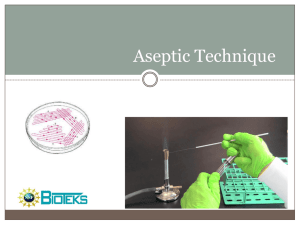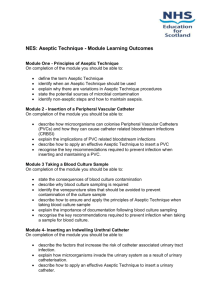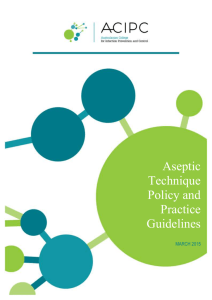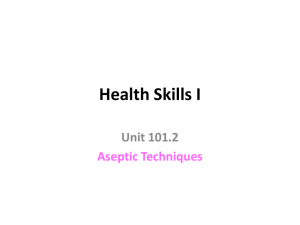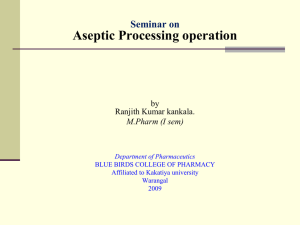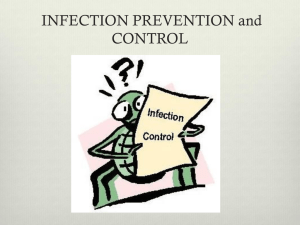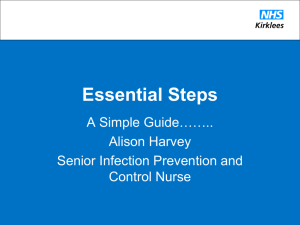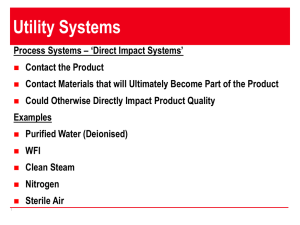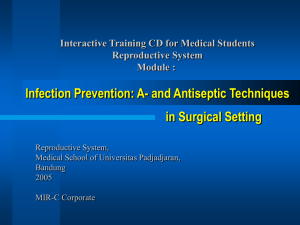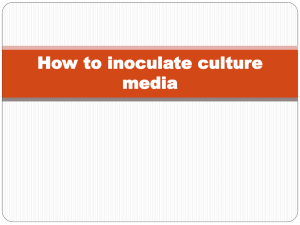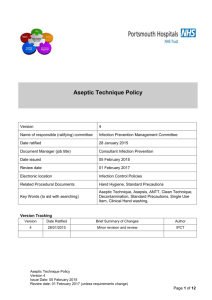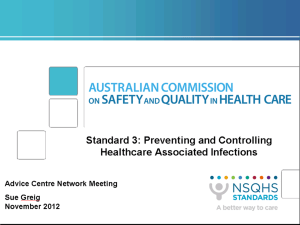Policy Title: Aseptic Technique during invasive clinical
advertisement
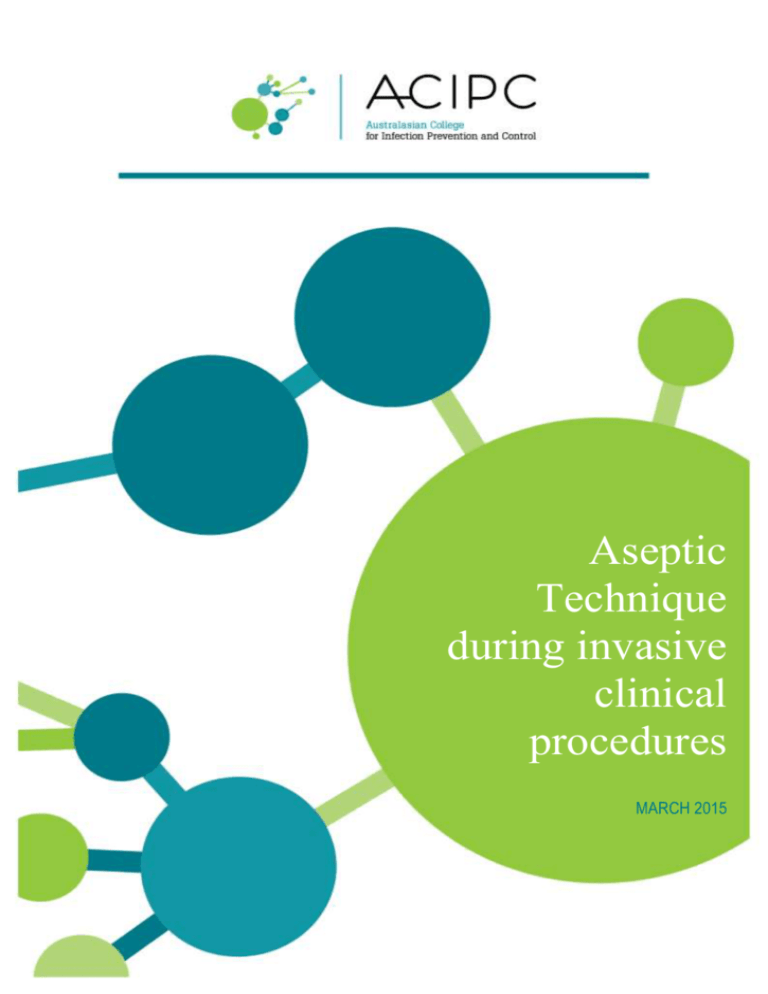
Aseptic Technique during invasive clinical procedures MARCH 2015 Table of Contents Policy Title: Aseptic technique during invasive clinical procedures ........................................................................................................ 2 1. Environmental Control Measures .................................................................................................................................................... 2 2. Infection Control Measures ............................................................................................................................................................. 2 3. Aseptic field selection and management......................................................................................................................................... 3 4. Non-touch technique ....................................................................................................................................................................... 3 5. Waste Management ........................................................................................................................................................................ 3 6. Cleaning of Equipment.................................................................................................................................................................... 3 APPENDIX .............................................................................................................................................................................................. 5 308871748 Reviewed: [Insert date] 1 Policy Title: Aseptic Technique during invasive clinical procedures This policy applies to All clinicians performing procedures in this organisation/facility/service. Purpose of policy and procedure Approximately 200,000 healthcare-associated infections (HAIs) occur in Australia each year, making them the most common complication affecting patients in hospital (1). These adverse events cause unnecessary pain and suffering for patients and their families, prolong hospital stays and increase health care costs to the patient, the organisation and the health system. Aseptic technique is an important clinical practice that reduces the risk of patients acquiring an infection during invasive clinical procedures (2). It is essential that all clinicians are properly educated and trained in Aseptic Technique (AT) and apply the principles to ensure efficient, safe and standardised aseptic practice during every procedure (3). This policy outlines the procedure for the application of aseptic technique for both standard and surgical procedures consistent with the NHMRC Infection Control Guidelines2. By following this policy and procedure clinicians are ensured standardisation of clinical practices, improved compliance with protecting key sites and parts and therefore minimised risk of infection to the patient. Policy aims 1. To ensure healthcare workers provide high quality standardised aseptic practice that conforms to evidence based practice guidelines. 2. To ensure clinicians understand the principles of Aseptic Technique and apply them to practice effectively. 3. To provide clinicians with a standardised approach to Aseptic Technique by which clinicians can be educated, assessed and monitored to ensure compliance to aseptic technique principles. Process 1. Environmental Control Measures Prior to conducting a procedure, clinicians should ensure that there are no avoidable environmental risks nearby. Environmental controls are used to reduce the risk of contamination by movement, touch or proximity. Examples of environmental risks may include: Bed making Cleaning the environment (if in close proximity) Use of commodes by other patients in a shared room Movement and proximity of privacy curtain Confined working area Excessive number of people present. 2. Infection Control Measures Hand hygiene: Effective hand hygiene is an essential part of AT. Routine hand hygiene should be performed using neutral pH soap and running water (duration of entire wash – 60 seconds) or an alcohol-based hand rub (duration of entire rub 20 – 30 seconds) Surgical hand scrub using an approved antimicrobial skin cleanser or waterless hand rub formulation is required when full barrier precautions are necessary. 308871748 Reviewed: [Insert date] 2 Glove use: Non-sterile gloves may be necessary to protect the clinician from blood or body fluids or exposure to toxic drugs during administration. Sterile gloves are required in all surgical aseptic procedures and any procedures where key parts and / or key sites are touched directly (i.e. when a non-touch technique cannot be achieved), to minimise the risk of contamination. Selection of sterile or non-sterile gloves is also dependent upon healthcare worker competency. When preparing for the procedure healthcare workers should assess their own competence and experience in performing the procedure and determine whether touching of key parts or sites is required. If touching may take place sterile gloves are required. Use of other protective personal equipment (PPE): Other PPE should be worn according to standard precautions to reduce the risk of blood and body fluid exposure to the clinician. Maximum barrier precautions may be required during invasive procedures to reduce the risk to the patient of acquiring a healthcare associated infection during procedures such as CVC insertion. 3. Aseptic field selection and management General aseptic fields that promote asepsis are used when- Key parts are easily protected by critical micro aseptic fields and non-touch technique The main aseptic field does not have to be managed as a key part. Management of the general aseptic field requires key parts be protected by Critical Micro Aseptic field (critical micro aseptic fields are those key parts protected by syringe caps, sheathed needles, covers or packaging). Asepsis of the immediate procedure environment is therefore promoted by general aseptic field management. Critical aseptic fields are used when- Key parts/sites are large or numerous and can’t be easily protected by covers or caps or can’t be handled with a non-touch technique Invasive procedures require a large aseptic working area. Management of the critical aseptic field requires only sterilised equipment to be placed in the aseptic field; sterile gloves are required to maintain asepsis. The aseptic field must be managed to ensure that key parts and key sites are protected and should be prepared as close as possible to the time of actual use. Selection of a tray or trolley of an appropriate size will ensure key parts are adequately contained within the aseptic field. Trays or trolleys should be cleaned with an appropriate disinfectant wipe and allowed to dry, before placing any items in or on the tray or trolley. If a surface remains wet then asepsis will be compromised. The aseptic field may also need to be extended by draping the patient. Sterile drapes provide additional work space where sterile equipment may be placed as well as protecting the key site from contamination. 4. Non-touch technique Non- touch technique is required at all times to maintain asepsis. Non-touch technique is a technique where the clinician’s hands do not touch, and thereby contaminate key parts and key sites. Asepsis can be achieved by either: Using a non-touch technique; examples include use of sterile gauze or sterile forceps Using sterile gloves. Even when sterile gloves are used, touching of key parts and key sites should not be touched unless necessary to do so. 5. Waste Management Waste and sharps must be discarded in the appropriate receptacle. 6. Cleaning of Equipment On completion of the aseptic procedure and once hand hygiene has been performed, all equipment used during procedure should be thoroughly cleaned using detergent and when required followed by a disinfectant. Cleaning followed by disinfection may be a two step or two in one process. 308871748 Reviewed: [Insert date] 3 Ensure all touch surfaces that have been used are cleaned well. Cleaned equipment should be allowed to dry properly before being put away. On completion of cleaning hand hygiene should be performed. Practice guidelines 1. Obtain consent from the patient, check for allergies and complete patient identification process using three nationally recognised identifiers. 2. Perform risk assessment and manage environmental risks. 3. Perform hand hygiene. 4. Clean the tray/trolley/work surface with detergent and water or detergent wipe. 5. Identify and gather equipment for procedure. Inspect packaging for damage; check sterility indicators & expiry dates, ensure any additional equipment, such as tourniquet, is clean. 6. Perform hand hygiene (clean hands effectively with soap and water or ABHR). 7. Prepare critical or general aseptic field. 8. Open procedure pack using corners and drop sterile equipment into sterile field. 9. Prepare patient – use gloves where appropriate to protect from potential body fluid exposure. 10. Remove gloves if used. 11. Perform hand hygiene. Note: For standard aseptic procedure, clean hands effectively with soap and water or ABHR. For surgical aseptic procedure a surgical hand scrub is required. 12. Apply gloves if required. Note: If it is necessary to touch key parts or key sites directly, sterile gloves are used to minimise the risk of contamination. Otherwise, non-sterile gloves are typically the gloves of choice for standard aseptic procedures. Sterile gloves are used for all surgical aseptic procedures. 13. Perform procedure ensuring all key parts/components are protected: Sterile items are used once and disposed into waste bag Only sterile items contact the key site Sterile items do not come into contact with non-sterile items. 14. Remove gloves (if used) and perform hand hygiene effectively with soap and water or ABHR. 15. Dispose of all waste (including sharps). Clean equipment and perform hand hygiene. Policy outcomes Aseptic technique is applied to any procedure where asepsis is required. Monitoring of performance Adherence to policy and patient outcomes will be regularly monitored. This will occur through the use of: Monitoring of hospital acquired infections Case review of patients with hospital acquired infections and clinical procedures associated with their care Auditing of compliance to AT practice guidelines (see Appendix) Monitoring of clinician training and education in AT Monitoring of clinician competency in AT (see Appendix). 308871748 Reviewed: [Insert date] 4 Responsibility This policy has been endorsed by the Hospital Executive and will be implemented by the Infection Control Management Team. Hospital/Line Managers are responsible for ensuring clinician compliance to policy. Steps to be taken by Line Manager or delegate if noncompliance is identified during a healthcare worker’s practice. Formal documented assessment of aseptic and non-touch technique practice Supervision of Healthcare worker’s practice until competence is demonstrated Notify Infection Control staff Provide further training and education Re-assess healthcare worker’s practice within one week of providing education. Acknowledgements This policy has been developed based on the recommendations of the NHMRC Australian Guidelines for the Prevention and Control of Infection in Healthcare (2). It has been adapted from resources developed by Princess Alexandra Hospital (Queensland), SA Health (South Australia) and The Queen Elizabeth Hospital (South Australia). References 4. Australian Commission on Safety and Quality in Health Care (ACSQHC). Windows into Safety and Quality in Health Care. Sydney, July 2009. 5. National Health and Medical Research Council (NHMRC). Australian Guidelines for the Prevention and Control of Infection in Healthcare. Commonwealth of Australia. Canberra 2010. 6. The Association for Safe Aseptic Practice. Aseptic Non Touch Technique (ANTT): A practice framework for clinical practice…from the operating theatre to the community. 2012; www.antt.org.uk. Accessed 18th April, 2014. APPENDIX Standard AT Procedure Audit Tool.docx Surgical AT Procedure Audit Tool.docx Standard AT Staff Competency.docx Surgical AT Staff Competency.docx 308871748 Reviewed: [Insert date] 5
